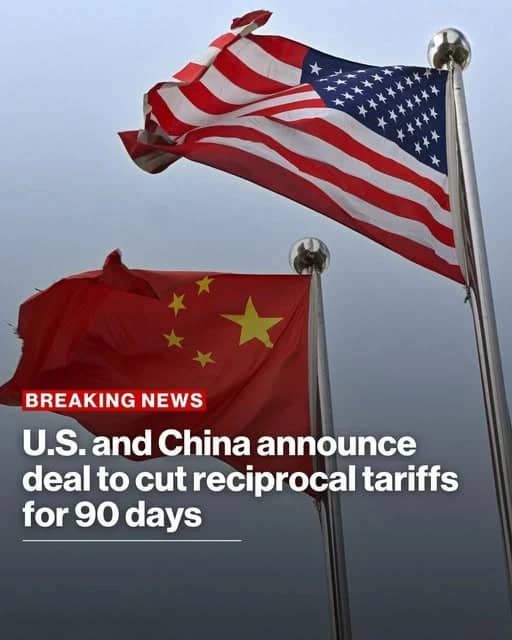On Monday, May 12, 2025, the United States and China made a significant announcement with a joint statement declaring a 90-day agreement to reduce reciprocal tariffs between the two countries. The deal was hailed as a positive step toward rebuilding a more sustainable, long-term, and mutually beneficial economic and trade relationship between the two global powers. Both sides expressed their recognition of the importance of such an agreement in the broader context of international trade and economic cooperation.
The announcement came after two days of intensive talks in Geneva, Switzerland, which both the U.S. and Chinese representatives described as successful. In a media briefing on Sunday, Chinese Vice Premier He Lifeng remarked that the discussions had resulted in substantial progress and important consensus, signaling a breakthrough in the ongoing trade negotiations between the two nations.
While the White House had previously indicated that a deal was reached, it did not provide specific details about the terms of the agreement. U.S. Trade Representative Jamieson Greer, who was in Switzerland for the talks, referred to the agreement as a “deal.” However, Treasury Secretary Scott Bessent, who also participated in the talks, expressed caution, stating that “substantial progress” had been made, but did not offer a definitive conclusion on the specifics of the accord.
The 90-day tariff reduction agreement comes amid a period of heightened trade tensions between the two countries, following years of disputes and the imposition of tariffs on billions of dollars’ worth of goods. These tariffs were initially introduced during the administration of former President Donald Trump as part of an effort to address concerns over intellectual property theft, trade imbalances, and unfair trade practices. Over time, both the U.S. and China retaliated by imposing their own tariffs on various goods, which ultimately led to a strained economic relationship.
The latest agreement is seen as a step toward easing these tensions and creating a path forward for further cooperation. By reducing tariffs, both sides are signaling a desire to prevent further escalation of the trade war that has had far-reaching consequences on global markets, supply chains, and businesses in both countries.
The fact that the talks were described as successful by both parties suggests that the two countries were able to make significant strides in resolving key issues that had been points of contention in previous negotiations. Chinese officials, including Vice Premier He Lifeng, have been vocal in emphasizing the importance of these trade talks and the progress that was made. He highlighted that the discussions had resulted in “substantial progress,” indicating that both sides had moved closer to reconciling their differences on some critical issues.
The details of the agreement remain unclear, and it is likely that further information will be released in the coming weeks as both sides continue to negotiate the terms of the deal. However, the joint statement released on Monday does indicate that the 90-day tariff reduction will be part of a broader effort to address trade imbalances and improve economic relations between the two countries. This is a significant development, as it marks the first concrete steps toward de-escalating the trade tensions that have dominated U.S.-China relations for several years.
The announcement of the agreement has been met with cautious optimism by business leaders and economists around the world, many of whom have been watching the trade war closely. The reduction of tariffs is seen as a welcome relief for many businesses, particularly those that rely on cross-border trade between the U.S. and China. The removal of tariffs on certain goods will likely help reduce costs for businesses and consumers, especially in industries such as manufacturing, agriculture, and technology, which have been disproportionately impacted by the trade war.
At the same time, there is still a great deal of uncertainty surrounding the long-term implications of the deal. While the 90-day tariff reduction is a positive step, many experts caution that it is only a temporary solution and that much work remains to be done in order to address the underlying issues that have driven the trade tensions between the two countries. Key areas of dispute, such as intellectual property rights, technology transfers, and market access, are expected to remain high on the agenda in future rounds of negotiations.
Despite the positive tone surrounding the agreement, the U.S.-China trade relationship remains complex and fraught with challenges. Both countries have competing interests when it comes to trade policies, and achieving a lasting resolution will require continued dialogue and compromise on both sides. The reduction of tariffs is just one piece of a much larger puzzle that will need to be addressed over the coming months and years.
In addition to the economic implications of the agreement, the 90-day tariff reduction also holds geopolitical significance. The trade war between the U.S. and China has had a profound impact on global politics, with both countries using tariffs and other trade measures as tools to exert influence over one another. As the world’s two largest economies, the relationship between the U.S. and China has far-reaching consequences not only for their own citizens but for countries around the world that are impacted by global supply chains, trade networks, and international markets.
The U.S.-China trade talks have also been closely watched by other nations, many of which have been caught in the crossfire of the trade war. Countries that rely on trade with either the U.S. or China have felt the ripple effects of the tariffs and economic uncertainty. As the U.S. and China work to resolve their differences, their actions will continue to shape the global economy and influence international trade policies.
Looking ahead, the next few months will be critical in determining the success of the 90-day tariff reduction agreement. Both sides will need to continue working together to address the broader issues that have long divided them, including intellectual property, market access, and the overall balance of trade. While the reduction of tariffs is a positive step, it is only one part of a much larger process that will require continued dialogue, negotiation, and compromise.
As the U.S. and China move forward with their efforts to rebuild their trade relationship, there is hope that the success of the latest talks will lead to more positive developments in the future. For now, the 90-day tariff reduction offers a glimmer of hope for businesses and consumers alike, signaling that a path toward greater economic cooperation may be within reach.
The joint statement issued by the U.S. and China on Monday marks a crucial turning point in their trade relationship. However, it is clear that much work remains to be done in order to secure a lasting resolution to the trade war. In the coming months, it will be important for both sides to stay committed to finding solutions to the complex issues that continue to divide them, with the ultimate goal of creating a fairer and more stable global trading system for all nations involved.
As this story continues to develop, both sides are expected to provide more details about the specific terms of the agreement and the next steps in their negotiations. For now, the world watches closely as the U.S. and China take steps toward a more harmonious and mutually beneficial economic future.


